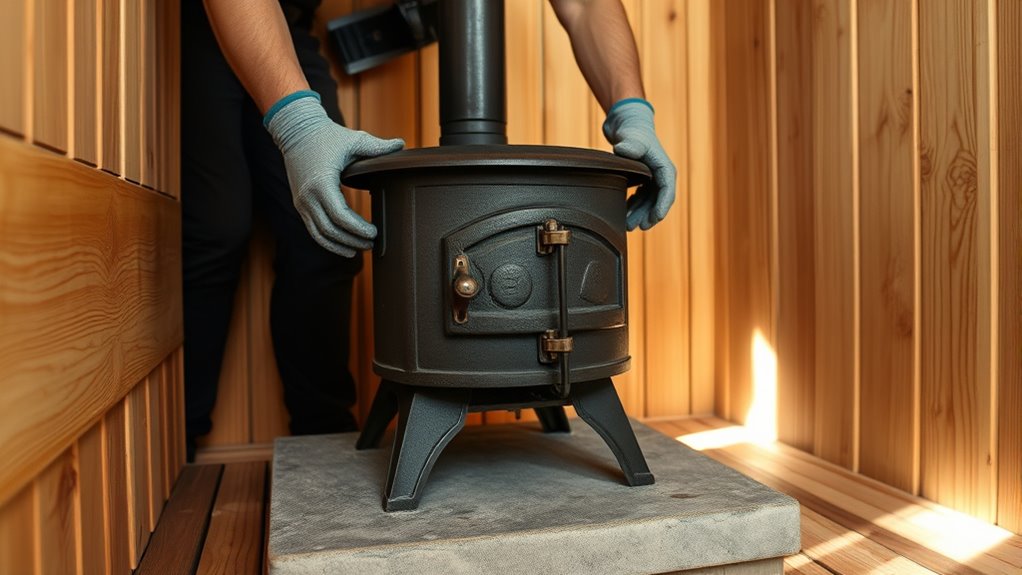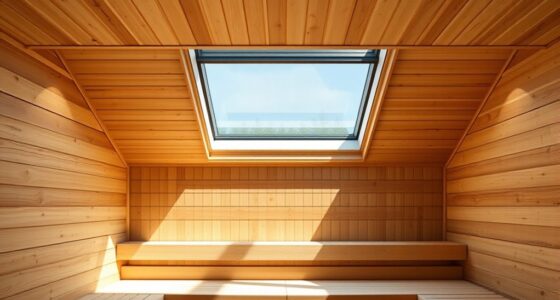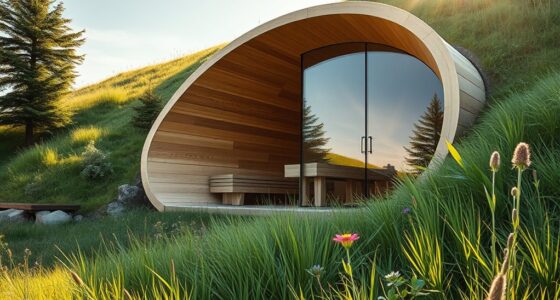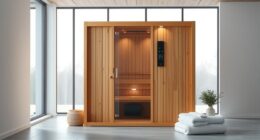To install your wood‑burning sauna stove safely, guarantee proper ventilation by installing intake vents for fresh air and exhaust for fumes, following local codes and manufacturer instructions. Keep the stove on a non-combustible surface and maintain clearances from combustible materials. Extend the chimney sufficiently above the roof for proper draft and inspect regularly for creosote buildup. Planning the layout carefully helps prevent obstructions and enhances safety—keep going to learn more essential tips.
Key Takeaways
- Ensure proper ventilation by installing intake vents near the stove and exhaust vents for fumes, following local building codes.
- Follow manufacturer specifications for chimney height, clearance, and use fire-resistant materials around the stove and chimney connection.
- Install the stove on a non-combustible surface and keep combustible materials away from the stove and chimney pipe.
- Plan the chimney run with adequate clearance above the roofline, avoiding tight bends and obstructions for proper draft.
- Regularly inspect and clean the chimney to prevent creosote buildup and ensure safe, efficient operation.
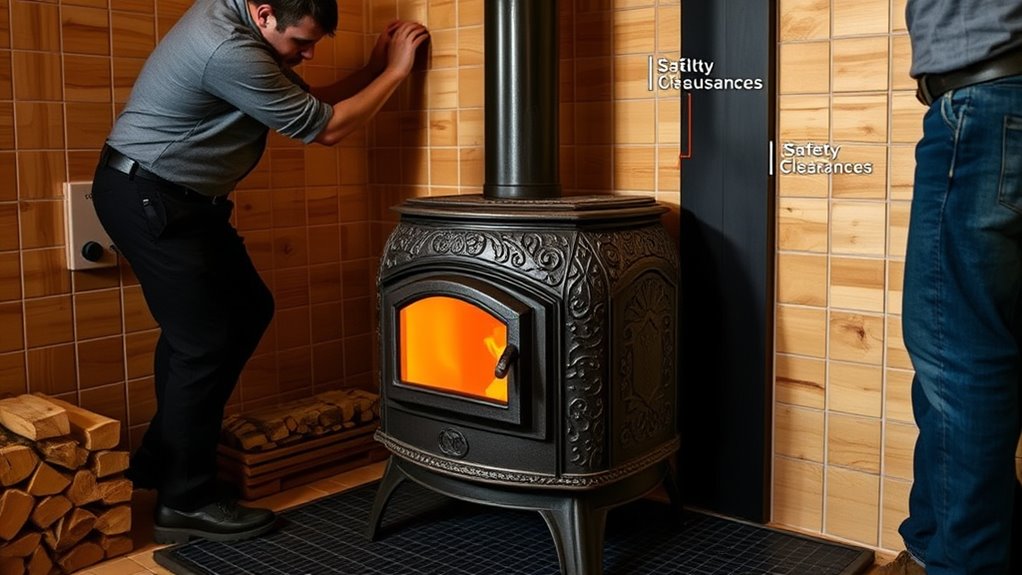
Installing a wood-burning sauna stove requires careful planning and attention to safety to guarantee a warm, relaxing experience without hazards. One of the most critical aspects is ensuring proper ventilation requirements. Adequate ventilation not only supplies fresh air for combustion but also helps remove smoke, gases, and excess moisture, preventing dangerous buildup inside the sauna. Before installation, check local building codes and manufacturer instructions to determine the specific ventilation needs. Typically, you’ll need an intake vent near the stove to bring in fresh air and an exhaust vent to vent out fumes. Proper airflow maintains safe oxygen levels and improves the stove’s efficiency. Neglecting ventilation can lead to poor air quality, increased risk of carbon monoxide buildup, and potential health hazards, so don’t overlook this step.
Another key factor is chimney clearance. When installing your stove, you must follow the manufacturer’s specifications for chimney height and clearance distances from combustible materials. The chimney should extend sufficiently above the roofline to ensure proper draft and prevent smoke from re-entering the sauna or neighboring structures. Maintaining the recommended chimney clearance also minimizes fire hazards by preventing heat transfer to combustible surfaces. Use fire-resistant materials around the stove and chimney connection, and double-check that the chimney pipe is securely attached and properly insulated. An improperly installed or too-short chimney can cause smoke spillage, inefficient burning, and increased safety risks. Regular inspection and cleaning of the chimney are essential to keep it free of creosote buildup, which can ignite and cause chimney fires.
Positioning your stove with respect to ventilation points and chimney clearance isn’t just about compliance; it’s about your safety and comfort. Make sure the stove is installed on a non-combustible surface and that there’s enough space around it for safe operation and maintenance. Keep combustible materials away from the stove and chimney pipe, and ensure there’s enough clearance for airflow and accessibility. When planning the installation, consider how the ventilation ducts and chimney will run through your sauna structure, avoiding tight bends or obstructions that could impair airflow. Additionally, understanding the types of cookies involved in related online resources can help you manage your privacy preferences during research. Before starting, review all manufacturer recommendations and local safety codes to prevent common installation pitfalls. Proper ventilation and chimney clearance aren’t just technical details—they’re essential safeguards that protect you and your loved ones while enjoying the soothing warmth of your sauna.
Frequently Asked Questions
Can I Install a Sauna Stove Outdoors Safely?
Yes, you can install a sauna stove outdoors safely if you prioritize outdoor durability and weather protection. Make sure the stove is placed on a non-combustible, level surface, and install a weather-resistant enclosure to shield it from rain, snow, and wind. Proper ventilation and fire safety measures are essential. Regular maintenance and inspections will help your outdoor sauna stove stay safe and functional, even in harsh weather conditions.
What Is the Ideal Clearance Distance From Combustible Materials?
You need to keep a super safe distance from combustible materials—think of it as an invisible fire shield! Follow the clearance guidelines strictly, usually at least 36 inches, to prevent any accidental fires. Ignoring these distances risks igniting nearby combustible materials, which can lead to dangerous situations. Always check your stove’s specific clearance requirements, and remember: safety isn’t just a suggestion, it’s a must to protect your sauna and home.
How Often Should I Inspect the Stove for Safety?
You should inspect your sauna stove at least once a month for safety. During inspections, check chimney maintenance to prevent creosote buildup and ensure proper airflow. Also, examine stove insulation for any damage or deterioration that could pose a fire risk. Regularly cleaning the chimney and maintaining insulation helps prevent dangerous malfunctions, keeping your sauna safe and efficient for years to come.
Are There Specific Ventilation Requirements for Outdoor Installations?
Think of outdoor installation as giving your sauna stove room to breathe. You should follow ventilation standards that guarantee proper outdoor airflow, preventing dangerous buildup of smoke or gases. Make sure the venting system directs fumes away from the sauna and neighboring areas. Adequate outdoor airflow not only keeps your setup safe but also enhances stove efficiency, allowing you to enjoy your sauna without worries.
What Safety Equipment Is Recommended During Installation?
During installation, you should wear protective gloves and safety goggles to shield yourself from sparks, hot surfaces, and debris. Gloves protect your hands from burns and cuts, while goggles prevent dust and ash from getting into your eyes. These safety items are essential to minimize risk and make certain the setup process is safe. Always prioritize safety gear to avoid injuries and make installation smoother and more secure.
Conclusion
Think of installing your sauna stove like planting a delicate seed. With patience, care, and attention to safety, you’ll nurture it into a warm, inviting oasis. When you follow these tips, you’re building more than just a stove—you’re cultivating a cozy retreat where relaxation blooms. Keep safety at the heart of every step, and soon, your sauna will be a sanctuary where stress melts away like morning mist in the dawn.
